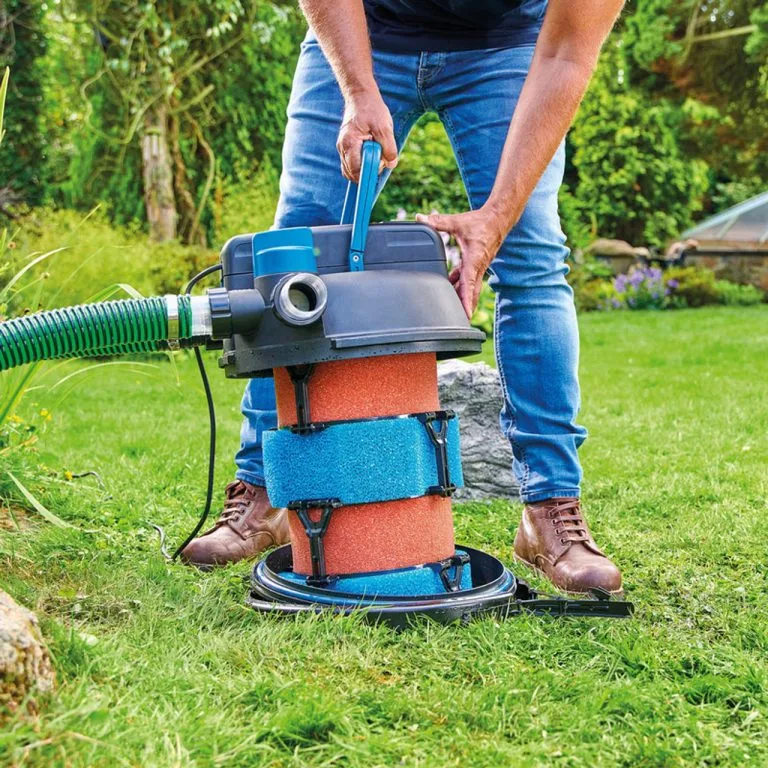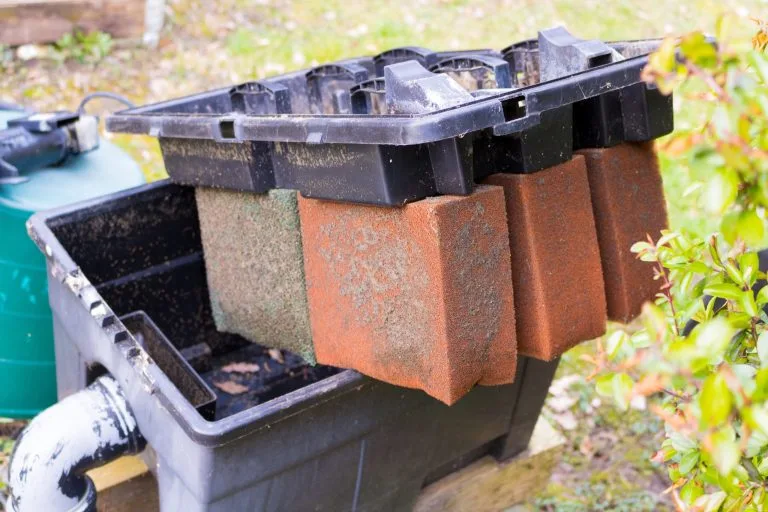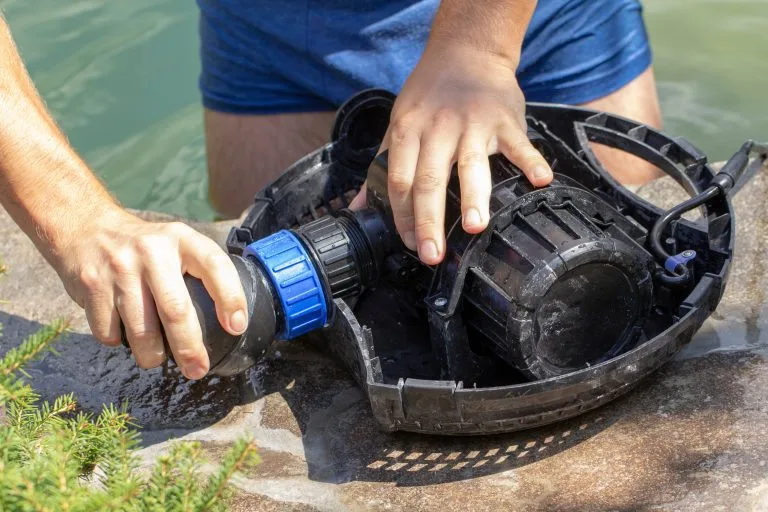Pond Equipment & Filtration Systems: Essential Components for Clear Water
Maintaining a clear and healthy pond requires proper filtration. A well-designed pond filter system is crucial for keeping the water clean and supporting aquatic life.


Pond Filtration Overview
Pump fed, gravity fed, trickle towers, centrifugal filters, sand filters, bead filters, multi chamber, automatic mechanical, biological filter system, or a pressurised filter system? Automatic mechanical and biological filter systems offer advanced self-cleaning and biological filtration capabilities, making them ideal for garden ponds by handling specific water volumes efficiently and operating even in the absence of the user.
Each filtration system, including pressure filters, has a specific flow rate and max pond size it can handle, ensuring you choose the right one for your pond’s needs.
Pond water filtration systems
Elevate the ecological balance of your pond with our market leading Evolution Aqua pond filtration systems.
Evolution Aqua pond systems, including Evolution Aqua’s Nexus320+ and Nexus220+ filters, offer advanced technology and innovative features for superior water clarity and health. Evolution Aqua’s K+ Advanced Pressure Filters and Nexus filters are designed for easy upgrades and compatibility with other filtration systems, utilizing proprietary K+Media for enhanced performance.
Why you need Pond pumps and filters for your pond size
Whether you have large fish ponds full of koi carp, ornamental ponds, garden ponds, freshwater ponds, a marine aquarium or anything else, you need a simple pond filter system at a minimum. If you have fish living in your pond, then they must receive the right oxygenation, deliver crystal clear water quality and a balanced environment to ensure healthy water.
In combination with yearly maintenance, pond filtration systems help remove debris, and stop algae growth and bacteria from building up, allowing the water to be clean, clear and aesthetically appealing. Many modern filters feature a self cleaning mechanism and an automatic cleaning cycle, which enhances efficiency by dislodging trapped debris. These filters are suitable for ponds up to 10,000 gallons, ensuring efficient waste removal and maintaining healthy water conditions. Pond pumps and filters also eliminate any harmful pollutants and substances like nitrates and anomia, converting them into less toxic compounds and making it healthy for marine life to live.
However, depending on your pond, there are so many filters to choose from, like pump fed, gravity fed, sand filters, bead filters, centrifugal filters, multi chambers, biological, mechanical, UV pressurised systems and more.
With over 30 years in this industry, we have a strong network with many major pond filter manufacturers/suppliers in the UK and Europe. Simply call us or allow us to visit, so we can discuss the best filtration solution for your pond.


Tips for Clarifiers, Filters and Pumps
As spring approaches, there’s a threat your pond might have green pond water. Therefore your pond’s ultra violated clarifier needs to be brought back into operation to counter the algae which caused it. An innovative polishing system and a mechanical barrier can further enhance water clarity and health. Plus, efficiency drops and less UV radiation is produced as the bulb ages, requiring a yearly replacement.
Using a surge filter can significantly improve pond water clarity and health. This innovative filtration system incorporates an 18-watt UV component and is versatile for various pond sizes, offering superior filtration capabilities and efficient maintenance.
The best time to do this is in spring, as the clarification effect is most needed in the opening few months of the season when the likelihood of algae blooms is at its highest. When changing the bulb, it is a good idea to check that the quartz tube it sits in is free of deposits or lime scale – a dirty tube will also cut down the amount of UV hitting the algae.
Cleaning the bio-filter is another task for this time of year, paying particular attention to shifting any old sludge that has settled so it does not get recycled back into the pond once you turn the pump back on.
Be sure to use pond water or rainwater to wash the filter, rather than tap water, to avoid introducing chlorine and other unwanted chemicals into the system. If possible, it is often a good idea to try to time things so that you can run the filter for a week or two before the weather really

Maintaining a clear and healthy pond requires proper filtration. A well-designed pond filter system is crucial for keeping the water clean and supporting aquatic life.
Pond filters come in various types:
- Mechanical filters
- Biological filters
- Chemical filters
- UV clarifiers
Mechanical filters remove debris and particles from the water. Biological filters support beneficial bacteria that break down harmful substances. Chemical filters use materials like activated carbon to remove impurities. UV clarifiers use ultraviolet light to control algae growth.
The size and type of filter needed depend on several factors:
- Pond volume
- Fish population
- Sunlight exposure
- Water features (e.g. streams or waterfalls)


For small garden ponds, an all-in-one filter system may suffice. Larger koi ponds often require more advanced filtration setups.
Pressure filters are popular for small to medium ponds. They are compact and can be placed away from the pond edge. Gravity-fed filters are typically used for larger ponds and require careful installation.
Regular maintenance is essential for optimal filter performance. This includes:
- Cleaning or replacing filter media
- Checking pump function
- Monitoring water quality
Proper filtration helps maintain the ecological balance of a pond. It supports beneficial bacteria growth and helps control algae blooms. In some cases, additional measures may be needed to combat persistent algae problems.
Pond owners should avoid frequent addition of tap water, as this can disrupt the pond’s balance. If topping up is necessary, using dechlorinated water is advisable.
When setting up a new pond, patience is key. It can take several weeks for the filtration system to establish and the pond to find its natural balance. Adding beneficial bacteria products can help speed up this process.
For koi ponds, more advanced filtration may be required due to the higher waste production of these fish. Specialised koi pond filters are designed to handle the increased bioload.
UV clarifiers can be an effective addition to combat green water caused by algae. They work by damaging algae cells as water passes through the unit.
It’s important to choose a pump that matches the filter capacity. An undersized pump will reduce filtration efficiency, while an oversized one may cause excessive water flow.
Pond owners should consider the following when selecting a filtration system:
- Pond size and depth
- Fish population and species
- Desired water clarity
- Budget constraints
- Maintenance requirements


Frequently Asked Questions
MY POND IS OVERGROWN.
MY POND IS LEAKING – WHAT CAN I DO?
WHY IS MY POND WATER GREEN?
Do I need to have my pumps running all the time?
Why Choose Us
Experience With years of experience in pond maintenance and cleaning, our team has the expertise to handle ponds of all sizes and complexities. We are dedicated to delivering high-quality services tailored to meet the unique needs of each customer.
Professionalism Our team consists of trained professionals who are passionate about pond care. We take pride in our work and strive to exceed our customers’ expectations with every service we provide.
Customised Solutions We understand that every pond is different, and we tailor our services to suit the specific requirements of each customer. Whether you have a small backyard pond or a larger water feature, we have the knowledge and resources to keep it in pristine condition.
Environmentally Friendly Practices We are committed to using eco-friendly products and methods in our pond cleaning services. Our goal is to promote sustainability and preserve the natural balance of your pond ecosystem.
Customer Satisfaction Your satisfaction is our top priority. We work closely with our customers to ensure that their pond maintenance needs are met with professionalism and care. We take the time to listen to your concerns and provide personalised recommendations to help you achieve the pond of your dreams.
Ready to schedule a pond cleaning service with us?
Contact Aqua Pond today to learn more about our services and to book an appointment.
Let us help you create a clean, healthy, and vibrant pond that you can enjoy for years. Thank you for considering Aqua Pond for your pond maintenance needs.
What our Customers Say...
